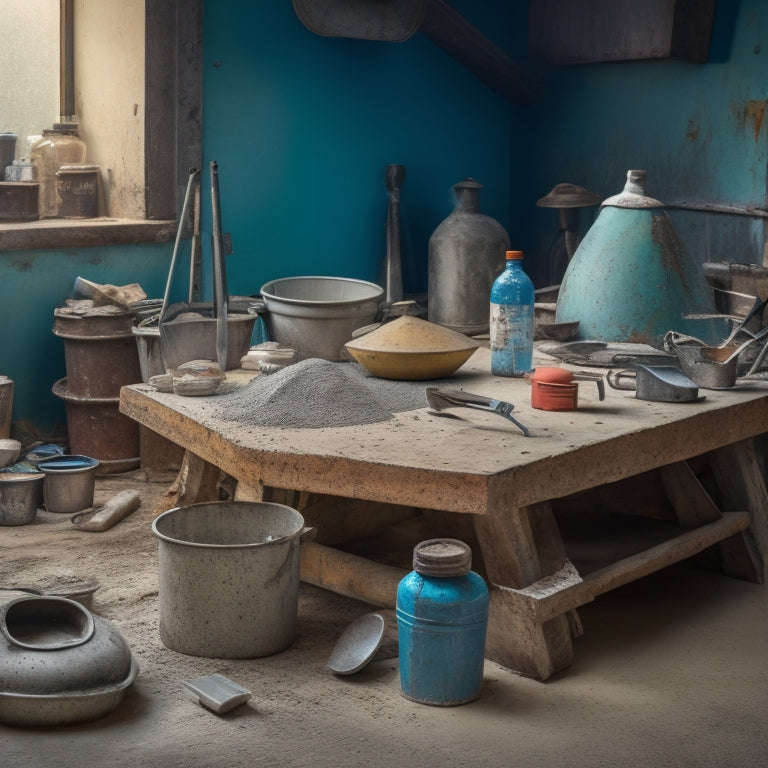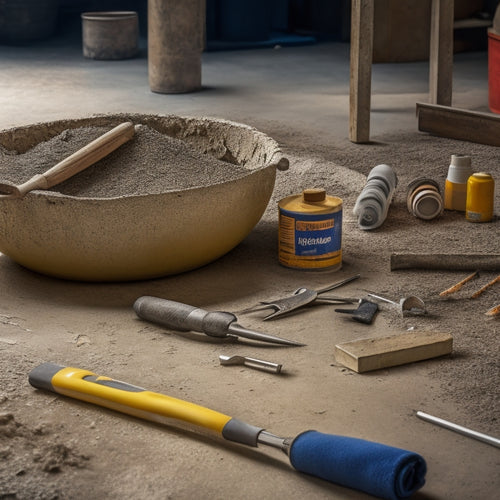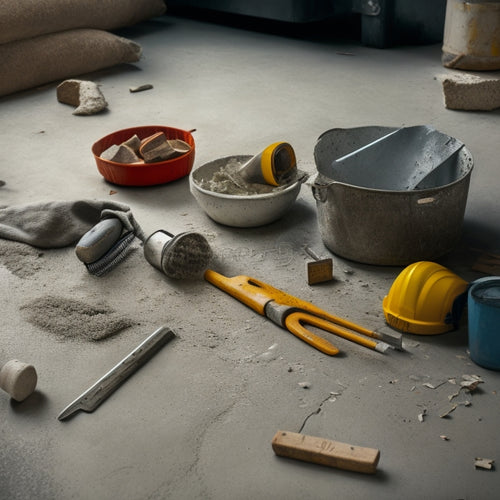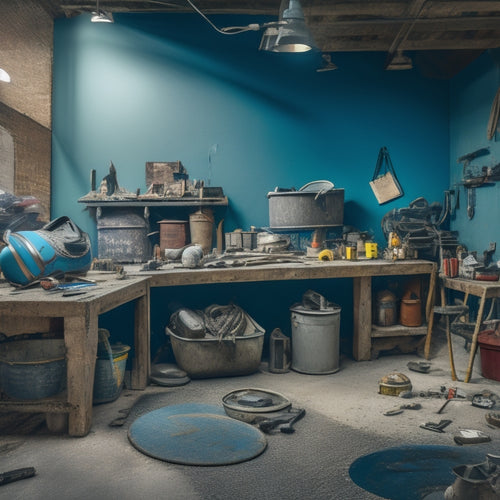
10 Best Concrete Mixing Tools for DIY Success
Share
When it comes to DIY concrete projects, you'll need the right tools to guarantee success. You'll require a sturdy mixing bucket that can handle heavy loads, a reliable mixing stick with a comfortable grip, and an efficient mixing paddle that can withstand intense mixing. Additionally, top-rated concrete trowels, concrete floats, and concrete brooms will help you achieve a smooth finish. You'll also need must-have concrete rakes, concrete edger options, and essential concrete scrapers to complete your project. By investing in these fundamental tools, you'll be well on your way to achieving professional-looking results, and understanding how to use them effectively is just the beginning.
Key Takeaways
• Prioritize sturdy, rust-resistant mixing buckets with durable, thick-walled designs to ensure safety and efficiency in DIY projects.
• Choose mixing sticks with sturdy materials, ergonomic handle grips, and well-designed mixing ends to optimize mixing efficiency and consistency.
• Select high-quality mixing paddles made from materials like stainless steel or fiberglass, with curved or angled blades for effective scraping and mixing.
• Consider the length and material of mixing tools, as they impact leverage, control, and comfort during use, and prioritize tools that reduce fatigue.
• Regularly maintain and clean mixing tools to prevent residue buildup, extend tool lifespan, and ensure optimal performance in DIY projects.
Essential Mixing Bucket Features
When selecting a mixing bucket for your DIY concrete project, look for one with sturdy, rust-resistant handles that can support the weight of the mixed concrete and withstand the rigors of repeated use.
The bucket's size is also important, as it directly affects the mixing process. A larger bucket allows for more concrete to be mixed at once, but may be heavier and more difficult to handle. Conversely, a smaller bucket is more manageable, but may require more frequent mixing. Reflect on the size of your project and the amount of concrete you'll need to mix when choosing the right bucket size.
In addition to handle durability and bucket size, mixing durability is a vital feature to contemplate. A mixing bucket with a durable, thick-walled design can withstand the intense mixing process and prevent cracks or breaks.
Look for buckets made from high-quality materials, such as heavy-duty plastic or metal, that can withstand the rigors of mixing concrete. By prioritizing these essential features, you'll be able to mix concrete safely and efficiently, ensuring a successful DIY project.
Top-Rated Concrete Trowels
With your mixing bucket selected, you'll need a reliable concrete trowel to shape and smooth the freshly poured concrete. Choosing the right trowel is essential for achieving a professional finish.
There are several trowel types to take into account, including finishing trowels, bull floats, and edging trowels. Each type is designed for specific tasks, such as smoothing, floating, or edging.
When selecting a trowel, ponder the materials used in its construction. Steel, aluminum, and magnesium are common materials used for trowel blades. Steel blades are durable and suitable for heavy-duty use, while aluminum blades are lightweight and ideal for smaller projects. Magnesium blades offer a balance between durability and weight.
Additionally, look for trowels with ergonomic handles designed to reduce fatigue and improve grip. A comfortable handle will allow you to work for extended periods without strain.
Verify the trowel you choose is well-balanced and easy to maneuver, allowing you to achieve a smooth, even finish. With the right trowel in hand, you'll be well on your way to a successful DIY concrete project.
Best Mixing Sticks for DIYers
When selecting the best mixing sticks for your DIY projects, you'll want to contemplate three key factors.
First, you'll need a sturdy stick that can withstand the rigors of mixing heavy concrete.
You'll also want to think about the ease of mixing action and the comfort of the handle grip, as these will impact your overall efficiency and productivity.
Sturdy Stick Options
You'll rely on a sturdy mixing stick to scrape the sides and bottom of your mixing bucket, guaranteeing every aggregate is well-coated with cement paste. A durable stick is essential, as it will withstand the rigors of mixing and scraping without breaking or bending. Look for sticks that have undergone rigorous durability testing to verify they can handle the demands of concrete mixing.
When selecting a mixing stick, consider the length that's right for you. A longer stick will give you more leverage and reach, making it easier to mix and scrape the entire bucket. However, a stick that's too long can be unwieldy and difficult to maneuver. A good starting point is a stick between 24 and 36 inches long.
In addition to durability and length, consider the material and handle design. A stick with a comfortable, non-slip grip will reduce fatigue and improve control. A fiberglass or steel shaft will provide the necessary strength and stiffness for efficient mixing.
Mixing Action Ease
Your mixing stick's performance relies on its ability to efficiently transfer your effort into mixing action, making a stick with a well-designed mixing end an essential factor in achieving ease of mixing.
A mixing stick with a poorly designed end can lead to ineffective mixing, resulting in inconsistent concrete quality and potential safety hazards. When choosing a mixing stick, look for one with a mixing end that's specifically designed to optimize mixing techniques.
A stick with a curved or angled end can help you achieve a more uniform mixing consistency, reducing the risk of air pockets and weak spots in the concrete.
To guarantee ease of mixing, consider a stick with a mixing end that's made from a durable, high-quality material, such as steel or fiberglass. These materials can withstand the rigors of mixing heavy concrete without breaking or bending, allowing you to focus on achieving the perfect mix.
Handle Grip Comfort
Handle Grip Comfort
A comfortable grip on your mixing stick's handle is essential, as it allows you to maintain control and apply the necessary force to mix concrete efficiently. A good grip prevents fatigue, reduces the risk of accidents, and guarantees you can focus on the mixing process. When choosing a mixing stick, look for an ergonomic design that fits comfortably in your hand. A contoured handle with a grip texture that provides traction will help you maintain a secure hold, even with gloved hands.
Here are some key features to take into account:
| Feature | Description | Importance |
|---|---|---|
| Ergonomic Design | Curved or angled handle to fit your hand | High |
| Grip Texture | Rubber or textured surface for traction | High |
| Handle Material | Durable, non-slip materials like fiberglass or wood | Medium |
Must-Have Concrete Rakes
When selecting a concrete rake, you'll need to contemplate the rake head options that suit your project's specific demands.
You'll want to think about the type of concrete you're working with, as well as the finish you're aiming for, to choose the right head style.
Additionally, you'll need to choose a handle material that provides the right balance of durability and comfort for your needs.
Rake Head Options
You'll find that having the right rake head options is essential for efficiently mixing and finishing concrete, as they enable you to tackle various tasks with precision and control. The rake head is the business end of your concrete rake, and choosing the right one can make all the difference in your DIY project.
When it comes to rake head options, you'll want to evaluate the type and material that best suits your needs. Here are some key considerations:
-
Tamping rake heads are ideal for compacting and leveling fresh concrete, with their flat, broad heads and sturdy teeth.
-
Finishing rake heads feature curved or angled teeth for smoothing and finishing concrete surfaces.
-
Notched rake heads have specially designed teeth for creating texture and pattern on concrete surfaces.
-
V-notch rake heads are great for creating precise, defined edges and joints in your concrete.
-
Flexible rake heads offer added versatility, with their spring-loaded teeth that conform to irregular surfaces.
Handle Material Choices
Concrete rakes' effectiveness hinges on the handle material, which particularly impacts comfort, durability, and overall performance during your DIY concrete project. When selecting a concrete rake, you'll encounter various handle materials, each with its pros and cons.
Fiberglass handles, for instance, are lightweight and resistant to corrosion, making them ideal for wet conditions. However, they may lack the durability of steel or aluminum handles, which are more robust but heavier.
You should prioritize handle ergonomics to guarantee a comfortable grip, reducing fatigue and strain during prolonged use. Look for handles with contoured grips, allowing your hands to fit snugly, and a balanced weight distribution to minimize strain on your back and shoulders.
Additionally, consider handles with non-slip coatings or textured surfaces to prevent accidents caused by slippery hands. Ultimately, a well-chosen handle material can greatly enhance your overall concrete mixing experience, ensuring you complete your project efficiently and safely.
Top Concrete Edger Options
Selecting the right edger from the numerous options available is crucial to achieving a professional-looking finish on your DIY concrete project. You'll want to choose an edger that suits your specific needs and guarantees a smooth, even finish.
When it comes to concrete edger types, you have several options to evaluate:
-
Manual edgers: These are affordable, easy to use, and perfect for small projects. They come with a straight or curved blade and are great for creating clean edges and joints.
-
Power edgers: These are ideal for larger projects and offer more power and efficiency. They're available in electric, gas, or pneumatic models.
-
Walk-behind edgers: These are designed for large, commercial projects and provide maximum power and control.
-
Tamping edgers: These combine edging and tamping functions, making them perfect for creating a smooth, compacted finish.
-
Radius edgers: These are designed for curved edges and offer a high level of precision and control.
Finishing Trowels for Perfection
When you're working with concrete, you'll soon realize that the right finishing trowel can make all the difference in achieving a smooth, professional finish.
To get the best results, you'll want to take into account three key factors: the angle of the trowel blade, the material and grip of the handle, and how easily the trowel can help you finish edges.
Trowel Blade Angles Matter
You'll achieve a superior finish by adjusting the blade angle of your finishing trowel to suit the specific stage of concrete placement and the desired surface texture. This essential step guarantees a smooth, even, and safe working environment.
When it comes to trowel blade types, you'll want to take into account the ideal trowel positioning for your project.
Here are some key factors for adjusting your trowel blade angle:
-
Early stages: Hold the trowel at a 45-degree angle to remove excess concrete and achieve a rough, textured surface.
-
Intermediate stages: Adjust to a 30-degree angle for a smoother finish, ideal for general-purpose applications.
-
Final stages: Use a 15-degree angle for a high-gloss, polished finish, perfect for decorative concrete or high-traffic areas.
-
Curved surfaces: Angle the trowel to match the curve, guaranteeing even coverage and a seamless finish.
-
Edge work: Hold the trowel almost flat (5-degree angle) to create a clean, defined edge.
Handle Material and Grip
Concrete finishing trowels' handle materials and grips play an essential role in achieving perfection, as they directly impact your comfort, control, and overall performance during the concrete finishing process.
As you work with concrete, you'll quickly realize that a good grip is crucial to maintaining control and precision. Look for handles made from high-quality materials that provide a secure grip, even with gloved hands. Ergonomic designs are a must, as they reduce fatigue and discomfort, allowing you to work for longer periods without strain.
When it comes to grip materials, you'll find a range of options available. Rubber grips are popular for their slip-resistance and shock-absorbing properties, while foam grips provide a comfortable, cushioned feel. Some handles may feature a combination of materials, such as a rubberized coating over a fiberglass core.
Whatever the material, make sure it feels comfortable in your hand and provides the control you need to achieve a smooth, even finish. A good grip can make all the difference in the quality of your work, so don't compromise on this critical aspect of your concrete finishing trowel.
Finishing Edges With Ease
Achieving perfectly finished edges requires a finishing trowel that's specifically designed to smooth out bumps, ridges, and other imperfections. With the right tool, you'll be able to achieve a professional-looking finish that enhances the overall appearance of your concrete project.
To get the best results, consider the following edge finishing techniques and decorative edge options:
-
Use a finishing trowel with a curved or angled blade to create a smooth, rounded edge.
-
Apply gentle to moderate pressure, depending on the type of concrete and desired finish.
-
Work in small sections, using long, sweeping strokes to feather the edge outwards.
-
Experiment with different decorative edge options, such as a chamfer or bevel edge, to add visual interest.
-
Always keep your finishing trowel clean and well-maintained to prevent scratching or marking the concrete.
Concrete Floats for Smooth Finish
When finishing a freshly poured slab, a well-chosen float helps to flatten and smooth the surface, removing imperfections and air pockets that can lead to an uneven finish.
You'll want to select a float made from durable materials, such as magnesium, aluminum, or resin, which can withstand the rigors of concrete finishing. The type of float you choose will also depend on the desired finish, with some floats designed for more aggressive finishing and others for more subtle smoothing.
To get the best results, it's crucial to master various float techniques. Start by holding the float at a 45-degree angle and applying gentle pressure, gradually increasing the pressure as needed.
Use long, sweeping strokes to cover the entire surface, working in sections to maintain even coverage. As you float, keep an eye out for any imperfections or air pockets, addressing them promptly to prevent them from setting.
Reliable Concrete Brooms
After completing the floating process, you'll need a reliable concrete broom to impart texture and create traction on the freshly smoothed surface. A high-quality broom is essential for guaranteeing the concrete surface is safe to walk on and resistant to slipping.
When selecting a concrete broom, consider the following factors:
-
Broom durability: Look for brooms with sturdy handles and bristles that can withstand the rigors of concrete finishing.
-
Broom texture: Choose a broom with bristles that provide the desired texture, from light to heavy, depending on your project requirements.
-
Bristle material: Opt for brooms with synthetic or natural fiber bristles, which are more durable and resistant to wear than wire bristles.
-
Handle length and material: Select a broom with a comfortable, ergonomic handle made from durable materials like fiberglass or wood.
-
Storage and maintenance: Consider brooms with easy-to-clean heads and storage-friendly designs to guarantee they remain in good condition between uses.
Mixing Paddles for Efficient Mixing
Effectively mixing concrete relies on using a mixing paddle that can withstand the rigors of blending heavy materials and aggressive mixing. When choosing a mixing paddle, you'll want to take into account the paddle material, as it plays an essential role in the mixing process. A durable, high-quality paddle made from materials like stainless steel or fiberglass can withstand the intense forces involved in concrete mixing.
A mixing paddle's design also impacts its performance. Look for paddles with curved or angled blades, which help to scrape the sides and bottom of the mixing bucket, guaranteeing a thorough mix. Additionally, take into account the paddle's handle length and material, as these factors affect your comfort and control during the mixing process. You'll want a handle that's long enough to provide leverage, yet comfortable to grip, reducing fatigue and strain.
When mixing, maintain a consistent mixing speed to prevent air pockets and guarantee a smooth, even consistency. Aim for a speed of around 10-15 revolutions per minute, adjusting as needed based on the specific mix design and materials.
Vital Concrete Scrapers
You'll also need a reliable concrete scraper to remove excess material from your mixing bucket and tools, guaranteeing a clean and efficient mixing process. This essential tool helps prevent material buildup, reduces waste, and saves you time and effort.
When choosing a scraper, consider the type of material you're working with and the size of your mixing bucket.
There are various scraper types, including:
-
Rigid scrapers for heavy-duty mixing and large buckets
-
Flexible scrapers for smaller buckets and delicate mixing
-
Notched scrapers for removing material from tight spaces
-
Edged scrapers for scraping and smoothing surfaces
-
Ergonomic scrapers for reduced fatigue and improved grip
To maintain your scraper and guarantee peak performance, follow these maintenance tips:
Regularly clean your scraper with soap and water to prevent material buildup.
Store your scraper in a dry place to prevent rust or corrosion.
Inspect your scraper regularly for signs of wear and tear, replacing it when necessary.
Use a scraper with a comfortable grip to reduce fatigue and improve control.
Frequently Asked Questions
What Safety Gear Is Required When Working With Concrete?
When working with concrete, you'll need to prioritize concrete safety by wearing the right protective equipment.
You should don a pair of durable gloves to shield your hands from abrasive concrete and harsh chemicals.
Safety glasses or goggles will protect your eyes from flying particles, while a dust mask or respirator will prevent inhalation of harmful dust.
Additionally, wear long sleeves, pants, and closed-toe shoes to minimize skin exposure.
Can I Mix Concrete in a Wheelbarrow Instead of a Bucket?
You might think a wheelbarrow is too big for mixing concrete, but it's actually a great option.
In fact, wheelbarrows offer more space to mix large batches and are often easier to maneuver than buckets.
When mixing in a wheelbarrow, use a shovel or mixing stick to fold the concrete towards the center, working in a figure-eight pattern to guarantee thorough mixing.
This technique helps prevent lumps and achieves a smooth consistency.
How Often Should I Clean My Concrete Mixing Tools?
You'll want to clean your concrete mixing tools regularly to prevent buildup and guarantee peak performance.
Aim to clean them after every use, or at least daily, to prevent concrete residue from hardening. This frequency will also help prevent rust and corrosion.
For tool maintenance, use a wire brush to remove debris, followed by a thorough rinse with water.
Dry tools thoroughly to prevent water spots.
Can I Use a Drill With a Mixing Paddle for Faster Mixing?
You're about to mix a mountain of concrete! Can you use a drill with a mixing paddle for faster mixing? Absolutely!
But, be sure to check your drill's specifications to verify it can handle the heavy-duty mixing. Opt for a drill with a high torque and variable speed control.
Then, master mixing techniques like slow, controlled movements and gradual speed increases to avoid splashing.
With the right drill and techniques, you'll be mixing like a pro in no time!
What Is the Ideal Temperature for Mixing and Pouring Concrete?
When mixing and pouring concrete, you'll want to aim for an ideal temperature between 50°F and 75°F (10°C and 24°C).
This range allows for optimal concrete curing, minimizing temperature effects that can cause uneven setting, cracking, or weakened structures.
Avoid mixing in direct sunlight, extreme temperatures, or windy conditions, as these can disrupt the curing process and compromise the concrete's integrity.
Conclusion
With the right concrete mixing tools, you've laid the foundation for a DIY project that's as solid as the ancient Roman Colosseum.
Just as the Colosseum's majestic structure has withstood the test of time, your concrete creations will endure with the help of these exceptional tools.
From mixing buckets to concrete brooms, each one plays an essential role in crafting a masterpiece that'll leave a lasting impression.
Now, go forth and build something that'll make the ancients proud!
Related Posts
-

Top Tools for Repairing Cracked Concrete Surfaces
When tackling a cracked concrete surface repair, you'll need the right tools to guarantee a durable fix. Start with e...
-

Top 10 Concrete Repair Tools for Small Fixes
You'll need the right tools to tackle small concrete repairs efficiently and effectively. When it comes to small fixe...
-

What Tools Do You Need for Concrete Flooring
You'll need a thorough arsenal of specialized tools to achieve a high-quality, professional-looking concrete floor, i...


